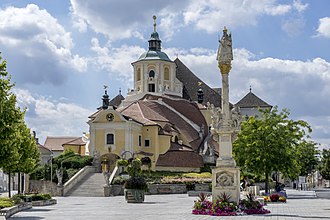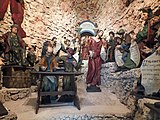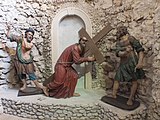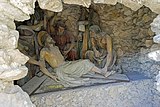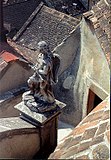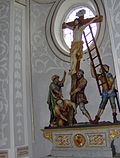Calvary Eisenstadt
The Kalvarienberg in Eisenstadt is an overbuilt, artificially built mountain, in which stairs and dark corridors lead past niches, grottos and small chapels. In it, the story of Christ's passion is depicted using groups of figures. The Kalvarienberg was built at the beginning of the 18th century and is a listed building . The mountain or Haydn church is built on the west side of the Kalvarienberg .
Location and description
The Eisenstädter Kalvarienberg is located on Kalvarienbergplatz, which in the Oberberg district connects to Esterhazystraße in a westerly direction. Outwardly it appears as a rising collection of small buildings covered by a moving roof landscape. About 30 stone angel figures on top guard the site. Behind it rises the massive block of the mountain church , which was built later.
A flight of stairs leads from the forecourt to the entrance chapel, the so-called Gnadenkapelle, which was originally called Getsemani or Mount of Olives Chapel. The beginning of the stairs and the arched portal of the vestibule are flanked by two angel figures. Next to the door to the chapel are the "peasant saints" Donatus and Leonhard . In the chapel, in front of the figurative scene of the Mount of Olives , the first station on the Way of the Cross, there is an altar of Mary with a copy of the miraculous image of Maria Einsiedeln under a richly decorated canopy above the columned tabernacle . The chapel also contains the oil paintings "Birth of the Lord in the stable of Bethlehem" and "Adoration of the Magi" as well as a small historical organ from 1820.
While the ordeal of Jesus in the crossroads is mostly represented in 14 stations, the Eisenstadt Calvary has 24, whereby the life of Mary is symbolically linked to the suffering of her son. The complex contains a total of 260 wooden and 60 stone figures, 10 chapels and 18 altars. The life-size figures, often depicted in pathetically exaggerated gestures and with coarse facial expressions, are brightly painted.
The three stations, Crucifixion, Christ on the Cross and Descent from the Cross, are located in the Kreuzkapelle, which towers above the entire complex.
The Kreuzkapelle is reached via an outside staircase. On the way up you pass some of the stone angels, whose attributes are related to the Passion, as well as one of the two small bell towers with gold-plated angels as a weather vane. From the cross chapel you have a wide view. The cross chapel is octagonal. Pilasters and pilaster strips structure its facade, and a dome-shaped roof with a lantern emphasizes its baroque character.
history
The construction of the Calvary was initiated by Prince Paul I. Esterházy (1635–1713), whom the Calvary in Maria Lanzendorf near Vienna , the construction of which had started in 1699, had made a great impression. Then he picked up the builder, Franciscans - lay brother Felix Nierinck, Eisenstadt and instructed him to build an even larger plant.
As early as 1701, the foundation stone was laid at a point on which a small Apollonia chapel had already been built in 1674 . The Kuruzenkrieg delayed construction. But in 1707 the consecration could be carried out by the bishop of Raab . The names of the amateur artists who created the figures are not known. In 1710 the cross chapel was completed.
In 1711, Prince Paul I had the miraculous image from Großhöflein , created in 1690 based on the model of Maria Einsiedeln by Eisenstadt sculptor Michael Felser († 1710), transferred to the entrance chapel, which was originally designed as the Ölberg chapel, and the chapel was redesigned accordingly. There it was the only one saved after a fire. In addition to the actual Calvary, the figure became the main attraction of pilgrimages in the 18th century .
There were up to 125 processions annually; In 1711 over 450,000 pilgrims came. During the period of enlightened absolutism and Josefinism in the second half of the 18th century, the importance of the calvaries and pilgrimages fell sharply, especially when multi-day pilgrimages were banned as such. The Eisenstadt Kalvarienberg was only accessible on Good Friday and fell into disrepair until the first renovation took place in the middle of the 19th century. Today it is considered one of Eisenstadt's tourist attractions. A fundamental renovation has been underway since 2015 under the motto "Kalvarienberg 2020".
literature
- Hans Kietaibl: Eisenstadt Calvary. In: Burgenland homeland sheets . 1998, issue 1, pp. 33-38, PDF on ZOBODAT
- Gunnar Strunz: Burgenland: Nature and culture between Lake Neusiedl and the Alps Trescher series of trips . 2012, ISBN 3-89794-221-6 , pp. 71 ( online in Google Book Search).
Web links
- Propstei- and Stadtpfarre Eisenstadt Oberberg: Kalvarienberg
- Viennatouristguide.at: The Kalvarienberg in Eisenstadt
Individual evidence
- ↑ a b Propstei- und Stadtpfarre Eisenstadt Oberberg: Gnadenkapelle ; Retrieved Nov. 30, 2017
- ↑ Kalvarienberg in Eisenstadt is being renovated for 1.2 million euros. Retrieved September 4, 2017 .
Coordinates: 47 ° 50 ′ 42 " N , 16 ° 30 ′ 44" E
